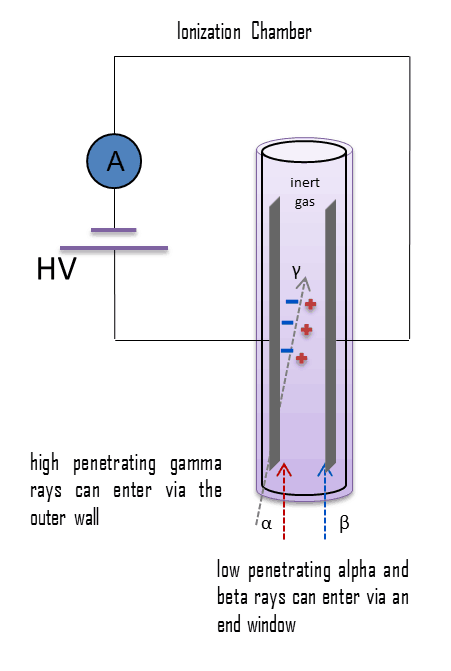 The chamber has a cathode and an anode that are held at some voltage (perhaps 100 – 200 V), and the device is characterized by a capacitance determined by the electrodes’ geometry. Flat plates or concentric cylinders may be utilized to construct an ionization chamber. The flat plate design is preferred because it has a well-defined active volume and ensures that ions will not collect on the insulators and cause electric field distortion. As ionizing radiation enters the gas between the electrodes, a finite number of ion pairs are formed. The behavior of the resultant ion pairs is affected by the potential gradient of the electric field within the gas and the type and pressure of the fill gas. Under the influence of the electric field, the positive ions will move toward the negatively charged electrode (outer cylinder or plate), and the negative ions (electrons) will migrate toward the positive electrode (central wire or plate). The electric field in this region keeps the ions from recombining with the electrons. Collecting these ions will produce a charge on the electrodes and an electrical pulse across the detection circuit. The average energy needed to produce an ion in the air is about 34 eV. Therefore, a 1 MeV radiation completely absorbed in the detector produces about 3 x 104 pairs of ions. However, it is a small signal that can be considerably amplified using standard electronics. A current of 1 micro-ampere consists of about 1012 electrons per second.
The chamber has a cathode and an anode that are held at some voltage (perhaps 100 – 200 V), and the device is characterized by a capacitance determined by the electrodes’ geometry. Flat plates or concentric cylinders may be utilized to construct an ionization chamber. The flat plate design is preferred because it has a well-defined active volume and ensures that ions will not collect on the insulators and cause electric field distortion. As ionizing radiation enters the gas between the electrodes, a finite number of ion pairs are formed. The behavior of the resultant ion pairs is affected by the potential gradient of the electric field within the gas and the type and pressure of the fill gas. Under the influence of the electric field, the positive ions will move toward the negatively charged electrode (outer cylinder or plate), and the negative ions (electrons) will migrate toward the positive electrode (central wire or plate). The electric field in this region keeps the ions from recombining with the electrons. Collecting these ions will produce a charge on the electrodes and an electrical pulse across the detection circuit. The average energy needed to produce an ion in the air is about 34 eV. Therefore, a 1 MeV radiation completely absorbed in the detector produces about 3 x 104 pairs of ions. However, it is a small signal that can be considerably amplified using standard electronics. A current of 1 micro-ampere consists of about 1012 electrons per second.
Ionization chamber construction differs from the proportional counter. The flat plate design is preferred for ionization chambers, or concentric cylinders may be utilized in the construction to allow for integrating pulses produced by the incident radiation. Proportional counters and Geiger counters usually utilize cylinder and central electrodes. The proportional counter would require such exact control of the electric field between the electrodes that it would not be practical.